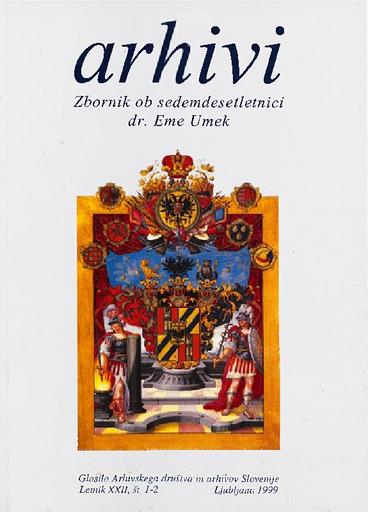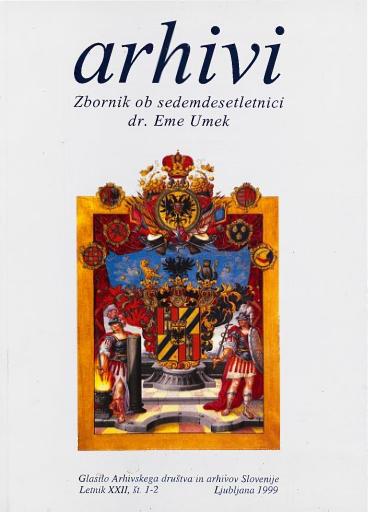/
Periodicals
/
Archives
The Institutions that Granted Scholarships for High School and University Students in Carinola

Author(s):Peter Ribnikar
Co-author(s):Matevž Košir (ur.)
Year:1999
Publisher(s):Arhivsko društvo Slovenije, Ljubljana
Source(s):Arhivi, 1999, št. 1-2
Language(s):slovenščina
Type(s) of material:text
Rights:

This work by Peter Ribnikar is licensed under Creative Commons Attribution-NonCommercial-NoDerivs 4.0 International
Files (1)

Name:ARHIVI_1999_1-2.pdf
Size:16.50MB
Format:application/pdf
Permanent link:https://hdl.handle.net/11686/file433
Description
In his article the author depicts the origins and roles
of the institutions registered in Carinola from 1601 to
1918 which granted scholarships to high school and
university students. The author provides a chronological
list of the institutions and presents the dala on their founders,
the number of available scholarships, how high the
scholarships were, who was liable to receive a scholarship,
the types of schools and the length of time the
scholarships were granted for, as well as the data on the
students who qualified to aipply for them.
These student grant institutions were established with
a founding charier by founders during their lifetimes or
by a will, with which they bequeathed a certain sum of
money or other assets in order to facilitate the education
of their relatives or other pupils or students in need of
such assistance. At first, only the students of secondary
schools and seminaries in Carniola, and students at universities
or higher colleges received grants. From the
19th century onwards, however, scholarships were also
granled to students at primary, lower high schools and
trade schools. Most of the founders intended their grants
for the education of their relatives, but in the event thai
they had none, the grants svere awarded to poor, but diligent
students in Carniola. The founding charters contained
all the regulations pertaining to the granting of
scholarships, such as the number of scholarships available,
the types of schools, the length of time for which
the scholarships were given, the data on the students that
qualified for scholarships, and in some cases also the
conditions set by the founders which the studcnls' had to
fulfil in order to keep their scholarships.
In the period from 1601 to 1918, 221 students' and
pupils' grant institutions were founded in Carniola. Of
these, 114 had one scholarship available. 49 two scholarships.
19 three, 8 four, 4 five, 3 six, 2 seven, 2 ten, 3
twelve, 1 sixteen, 1 twenty and 1 twenty-four scholarships
available.
Metadata (12)
- identifierhttps://hdl.handle.net/11686/10195
- title
- Študentske in dijaške štipendijske ustanove na Kranjskem
- The Institutions that Granted Scholarships for High School and University Students in Carinola
- creator
- Peter Ribnikar
- contributor
- Matevž Košir (ur.)
- subject
- štipendije
- dobrodelnost
- šolstvo
- Kranjska
- Carniola
- education
- scholarships
- description
- In his article the author depicts the origins and roles of the institutions registered in Carinola from 1601 to 1918 which granted scholarships to high school and university students. The author provides a chronological list of the institutions and presents the dala on their founders, the number of available scholarships, how high the scholarships were, who was liable to receive a scholarship, the types of schools and the length of time the scholarships were granted for, as well as the data on the students who qualified to aipply for them. These student grant institutions were established with a founding charier by founders during their lifetimes or by a will, with which they bequeathed a certain sum of money or other assets in order to facilitate the education of their relatives or other pupils or students in need of such assistance. At first, only the students of secondary schools and seminaries in Carniola, and students at universities or higher colleges received grants. From the 19th century onwards, however, scholarships were also granled to students at primary, lower high schools and trade schools. Most of the founders intended their grants for the education of their relatives, but in the event thai they had none, the grants svere awarded to poor, but diligent students in Carniola. The founding charters contained all the regulations pertaining to the granting of scholarships, such as the number of scholarships available, the types of schools, the length of time for which the scholarships were given, the data on the students that qualified for scholarships, and in some cases also the conditions set by the founders which the studcnls' had to fulfil in order to keep their scholarships. In the period from 1601 to 1918, 221 students' and pupils' grant institutions were founded in Carniola. Of these, 114 had one scholarship available. 49 two scholarships. 19 three, 8 four, 4 five, 3 six, 2 seven, 2 ten, 3 twelve, 1 sixteen, 1 twenty and 1 twenty-four scholarships available.
- Avtor v članku prikazuje nastanek in vlogo študentskih in dijaških štipendijskih ustanov, ki so bile registrirane na Kranjskem v letih od 1601 do 1918. Nadalje podaja kronološki seznam štipendijskih ustanov s podatki o ustanovnikih, številu štipendijskih mest, višini štipendije, upravičencu do prejemanja štipendije, vrsti šole z rokom trajanja prejemanja štipendije ter podatke o upravičencu za podeljevanje štipendije. Študentske štipendijske ustanove so z ustanovno listino ustanovniki ustanavljali še za svojega življenja. V testamentu so z. izraženo poslednjo voljo namenjali neko vsoto denarja in drugega premoženja šolanju svojih sorodnikov in drugim dijakom in študentom, potrebnim podpore. Sprva so sprejemali štipendije le dijaki srednjih šol in semenišč na Kranjskem ter študenti univerz, in visokih šol, od 19. stoletja dalje pa tudi učenci osnovnih, meščanskih in obrtnih šol. Večina ustanovnikov je štipendije namenjala šolanju svojih sorodnikov, če teh ni bilo, pa so jih prejemali drugi revni, pridni študirajoči mladeniči na Kranjskem. Ustanovne listine so vsebovale vsa določila o podeljevanju štipendij, predvsem podatke o številu štipendijskih mest, o višini štipendije, vrsti šole, času trajanju štipendiranja, podatke o upravičencih za podeljevanje štipendij, v nekaterih primerih pa so bile v njih tudi zahteve uslanovnika do prejemnika štipendije. V obdobju od 1601 do 1918 je bilo na Kranjskem ustanovljeno 221 štipendijskih oziroma dijaških štipendijskih ustanov, od teh jih je imelo 114 po eno, 49 po dve, 19 po tri, 8 po štiri, 4 po pet, 3 po šest, 2 po sedem, 2 po deset, 3 po dvanajst, 1 po šestnajst, 1 po dvajset in 1 po štiriindvajset štipendijskih mest.
- publisher
- Arhivsko društvo Slovenije
- date
- 1999
- type
- besedilo
- language
- Slovenščina
- isPartOf
- rights
- license: ccByNcNd
Citirano v (1)
| Tipologija | Avtor(ji) | Naslov | Kraj | Založba | Leto |
|---|---|---|---|---|---|
| 1.01 Izvirni znanstveni članek | Šimac, Miha | Iz življenja pozabljenega mecena : oporoka Venclja Arka (1826-1901) | Ljubljana | Zveza zgodovinskih društev Slovenije | 2020 |
